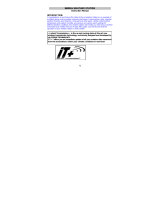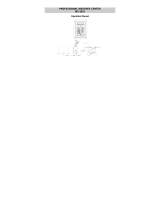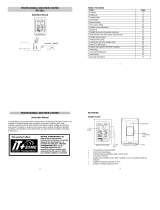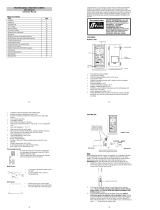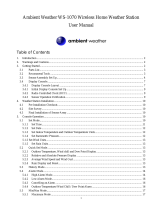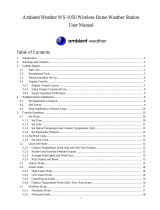Page is loading ...

64
868MHz WEATHER STATION
Instruction Manual
INTRODUCTION:
Congratulations on purchasing this state-of-the-art weather station as an example of
excellent design and innovative measuring technique. Featuring time, date, calendar,
weather forecast, wind direction, wind gust and wind speed, rainfall, indoor/outdoor
temperature and outdoor humidity, air pressure and various alarm settings for
different weather conditions, this weather station will provide you with various weather
information and weather forecast. Pages after pages, you will discover that the
operation of your weather station is really simple !
« Instant Transmission+» is the up and coming state-of-the-art new wireless
transmission technology, exclusively designed and developed by LA
CROSSE TECHNOLOGY.
“IT +” offers you an immediate update of all your outdoor data measured
from the transmitters: follow your climatic variations in real-time!

65
FEATURES:
The Multifunctional Weather Station
•
Time display (manual setting)
•
12/24 hour time display
•
Calendar display (weekday, date, month, year)
•
Time alarm function
•
Weather forecasting function with 3 weather icons and weather tendency
indicator
•
Indoor temperature display in °C/ºF
•
Outdoor temperature display in °C/ºF
•
Outdoor Humidity display as RH%
•
Dew point displayed in °C or °F
Function keys
Hanging hole
LCD display
Detachable stand
Battery
compartment
cover

66
•
Wind gust displayed in km/h, mph, m/s
•
24-hour and total rainfall displayed in mm or inch
•
Display Max / Min value of outdoor temperature, outdoor humidity, Dew point,
Wind chill, and Relative pressure, with time & date of recording
•
Display max wind speed, max gust, max 24h rainfall and total rainfall with time
& date of recording
•
Low/High outdoor temperature, outdoor humidity and high wind speed alarm
•
Relative air pressure displayed in hPa or inHg
•
Air pressure tendency indicator for the past 12 hour (bargraph format)
•
LCD contrast selectable
•
Low battery indicator
•
Wind direction displayed in 16 steps
•
Wind speed displayed in km/h, mph or m/s, and Beaufort scale
•
Wind chill displayed in °C of °F
•
Manual reset of outdoor temperature/ humidity, pressure, windchill, dew point,
wind speed, gust, 24h rainfall and total rainfall data
•
Storm warning alarm
•
Buzzer on/ off selectable
•
Storage of 140 sets of history weather data recorded in 3-hour intervals
•
Wireless transmission at 868 MHz
•
Transmission range up to 100 metres

67
The Thermo-HygroTransmitter
•
Remote transmission of the outdoor temperature and humidity to
the Weather Station at 868 MHz
•
Showerproof casing
•
Wall mounting case (to be mounted in a sheltered place. Avoid
direct rain and sunshine)
The Wind Sensor
•
Connected to the thermo-hygro transmitter by
cable
•
Can be installed onto a mast or a horizontal panel
The Rain Sensor
•
Remote transmission of the rainfall data to
the Weather Station at 868 MHz
•
To be mounted onto a horizontal panel

68
W
ireless
transmission at
868 MHz
-
thermo-
hygro
transmitter to
weather
station
Cable connection between the wind sensor
and the thermo-hygro transmitter
Wireless transmission at
868 MHz – Rain sensor
to weather station
Weather station
Wind sensor
Rain sensor
hermo
-
hygro
transmitter
SETTING UP:
T
Note:
When putting the Weather Station into operation, it is important to perform in close
proximity (e.g. on a table) a complete wiring and set-up of the system. This step is
important to test all components for correct function before placing and mounting

69
Socket for wind
sensor
them at their final destinations (See Positioning below). Spin the wind vane and tip
the rain gauge to test.
1. Unwind the cables of the Wind sensor. Connect the Wind sensor to the Thermo-
hygro transmitter by plugging the connector heads into the sockets of the
Thermo-hygro transmitter. Cord should “click” into place.
2. First insert the batteries into the Thermo-hygro transmitter and Rain sensor (see
“How to install and replace the batteries into the Thermo-hygro
transmitter“ & How to install and replace batteries into the Rain sensor
below).
3. Then insert the batteries into the Weather Station (see “How to install and
replace the batteries into the Weather Station” below). Once the batteries are
installed, all segments of the LCD will light up briefly and a short signal tone will
be heard. It will then display the time as 00:00, the date as 1.1.05, the weather
icons, and air pressure value. "- - -" will be shown for outdoor data.

70
4. Afterwards, the Weather Center will start receiving data from the transmitter.
The transmission reception icon will be blinking to indicate that the station is
trying to get the thermo-hygro transmitter data. The outdoor temperature,
humidity, wind data should then be displayed on the Weather Center. If this
does not happen after 45 seconds, the batteries will need to be removed from
all units. You will have to start again from step 2.
5. The transmitter reception icon is now blinking again to indicate that the station is
trying to get the rain sensor data. It will stop blinking once the rain sensor has
been detected. If this does not happen after 45 seconds, you will need to start
again from step 2.
6. You may need to check the cable for correct connection and all the components
for correct function by manually turning the wind-gauge by moving the wind-
vane; tilting the rain sensor to hear the impact of the internal moving seesaw,
etc. (see Positioning below).
7. Time and date shall be manually set (See Manual Setting below).
8. After the Weather Station has been checked for correct function with regard to
the above points and found fit, the initial set up of the weather station system is
finished and the mounting of the system components can take place. It must be
ensured however that all components work properly together at their chosen
mounting or standing locations. If e.g. there appear to be problems with the 868
MHz radio transmission, they can mostly be overcome by slightly changing the
mounting locations.
Note:
The radio communication between the receiver and the transmitter in the open field
reaches distances of max 100 metres, provided there are no interfering obstacles
such as buildings, trees, vehicles, high voltage lines, etc.

71
9. Radio interferences created by PC screens, radios or TV sets can in some
cases entirely cut off radio communication. Please take this into consideration
when choosing standing or mounting locations.
Note :
•
After batteries are installed in the transmitter, install the batteries in the weather
center to receive the signal from the transmitters as soon as possible. If the
weather center is powered more than 5 hours after the transmitter is powered,
the weather center will never receive signal successfully from the transmitters.
In this case, user will need to reinstall the batteries from all the transmitters to
redo set-up procedure.
•
After batteries are installed, there will be synchronization between weather
center and the transmitters. At this time, the signal reception icon will be blinking.
When the signal is successfully received by the weather center, the icon will be
switched on. (If it is not successful, the icon will not be shown in LCD) So the
user can easily see whether the last reception was successful (icon on) or not
(icon off). On the other hand, the short blinking of the icon shows that a
reception is in progress.
Transmitter signal
reception icon

72
HOW TO INSTALL AND REPLACE THE BATTERIES INTO THE
WEATHER STATION
The Weather Station works with 3 x AA, IEC LR6, 1.5V
batteries. When the batteries need to be replaced, the
low battery symbol will appear on the LCD.
To install and replace the batteries, please follow the
steps below:
1. Remove the battery compartment cover.
2. Insert the batteries observing the correct polarity
(see the marking in the battery compartment).
3. Replace the battery cover.
HOW TO INSTALL AND REPLACE BATTERIES INTO THE RAIN
SENSOR
The rain sensor works with 2 x AAA, IEC LR3, 1.5V Alkaline batteries. To install and
replace the batteries, please follow the steps below:
1. Press tabs back to unlock rain sensor cover. (Figure 1)
Figure 1
Figure 2
Figure 3

73
2. Lift rain sensor cover to access battery compartment. (Figure 2)
3. Insert the batteries, observing the correct polarity (see the marking in the battery
compartment). (Figure 3)
4. Replace the battery cover and the rain cover onto the unit.
Note:
In the event of changing batteries in any of the units, all units need to be reset by
following the setting up procedures. This is because a random security code is
assigned by the rain sensor at start-up and this code must be received and stored by
the Weather Center in the first several minutes of power being supplied to it.
HOW TO INSTALL AND REPLACE THE BATTERIES INTO THE
THERMO-HYGRO TRANSMITTER
The outdoor Thermo-hygro transmitter works with 2 x AA IEC
LR6, 1.5V batteries. To install and replace the batteries, please
follow the steps below:
1. Uninstall the rain cover of the transmitter.
2. Remove the battery compartment cover.
3. Insert the batteries, observing the correct polarity (see the
marking in the battery compartment).
4. Replace the battery cover and the rain cover onto the unit.
Note:
In the event of changing batteries in any of the units, all units
need to be reset by following the setting up procedures. This is
because a random security code is assigned by the transmitter and rain sensor at
start-up and this code must be received and stored by the Weather Station in the first
several minutes of power being supplied to it.

74
BATTERY CHANGE:
It is recommended to replace the batteries in all units every 24 months to
ensure optimum accuracy of these units. (Battery life –see
Specifications)
Please participate in the preservation of the environment. Return
used batteries to an authorised depot.
Note:
The stored History record will not be kept after the battery change is done on the
weather station.
FUNCTION KEYS:
Weather Station:
The Weather Station has 5 easy-to-use function keys.
MIN/MAX key
SET/MODE key
+ key
HISTORY key
ALARM key

75
SET/MODE key
•
Press and hold to enter manual setting modes: LCD contrast, Manual time
setting, 12/24 hour time display, Calendar setting, ºC/ ºF temperature unit, Wind
speed unit, Rainfall unit, Pressure unit, Relative pressure reference setting,
Weather tendency threshold setting, Storm warning threshold setting and Storm
Alarm On/ Off setting
•
Press to toggle between the display of Mode 1 or Mode 2:
Mode1: "Wind speed + outdoor temp + rel. pressure"
Mode 2: "Gust + Dew Point temp + rainfall"
(Mode 2 displayed will be shown for 30 seconds. Then it will return to
normal display automatically.)
•
In normal display mode, press and hold to switch on/ off the Buzzer
•
In the weather alarm setting mode, press and hold to adjust different alarm
value and switch the alarm On/ Off
•
Press to activate the reset mode when max or min record is shown
•
Stop the alarm during the time alarm or weather alarm ringing
+ key
•
In display Mode 1, press to toggle between the display of Preset alarm time,
date, weekday + date, Indoor temp, or second in the time display
•
In display mode 2, press to toggle between the display of Rel. Pressure, 24 hour
rainfall and Total rainfall
•
Press to adjust (increase) the level of different settings
•
Stop the alarm during the time alarm or weather alarm ringing
•
Press to confirm to reset the max/min record
•
Press to reset the total rainfall amount to 0

76
HISTORY key
•
Press to display the weather data history records
•
Stop the alarm during the time alarm or weather alarm ringing
•
Press to exit manual setting mode and alarm setting mode
ALARM key
•
Press to enter the time alarm and weather alarm setting mode
•
Confirm particular alarm setting
•
Press to exit the manual setting mode
•
Stop the alarm during the time alarm or weather alarm ringing
•
Press to exit max/ min record display mode
MIN/MAX key
•
Press to display minimum and maximum records of various weather data
•
Press to adjust (decrease) the level of different settings
•
Stop the alarm during the time alarm or weather alarm ringing
LCD SCREEN
The LCD screen is split into 5 sections displaying the following information:
1. Time and date/ indoor temp/ second
2. Wind data
3. Outdoor temperature, Dew point and humidity,
4. Air pressure, Rainfall data
5. Air pressure history and Weather forecast icon.

77
Air pressure
histogram
Outdoor
temperature or dew point
in °F or ºC
Wind direction display
and wind speed in
Beaufort scale
Calendar, indoor temp.,
or alarm time display
Weather tendency
indicator
Time display
Time alarm icon
Outdoor relative
humidity in %
Weather forecast
icon
Relative air pressure
display in inHg or
hPa, or
total and 24h rainfall
display in inch or mm
Wind speed or gust *
in
mph
,
km/h
or m/s
Wind Chill
in °F or °
C
Wind speed Hi
alarm icon
Outdoor Humidity
alarm icon
Outdoor temp.
alarm icon
Low battery Indicator (rain sensor)
Low battery Indicator (Thermo-hygro)
Transmitter signal
reception icon#
Buz
zer off indicator
Low battery Indicator (weather station)

78
# When the signal from the transmitter/ or Rain sensor is successfully received by the
Weather Station, this icon will be switched on. (If not successful, the icon will not be
shown on the LCD). User can therefore easily see whether the last reception was
successful (“ON” icon) or not (“OFF” icon). On the other hand, the short blinking of the
icon shows that a reception is being done at that time.
* In normal display user may press the SET key shortly to toggle between Mode1 and
Mode 2 display:
Mode 1 : Wind speed, outdoor temperature and relative pressure reading are shown.
Wind speed icon
Outdoor temp
icon
Rel Press
ure
icon
In Mode 1, this reception
icon is showing the
condition of the
reception of the signal
from Thermo-hygro
transmitter

79
Mode 2 : Wind Gust, Dew Point temperature and Rainfall reading are shown.
MANUAL SETTINGS:
The following manual settings can be changed once the SET key is pressed and hold
for about 3 seconds:
•
LCD contrast setting
•
Manual time setting
•
12/24 hour time display
•
Calendar setting
•
°C/ °F temperature unit setting
•
Wind speed unit
•
Rainfall unit setting
•
Air pressure unit setting
•
Relative pressure reference value setting
•
Weather tendency threshold value
•
Storm warning threshold value
•
Storm alarm On/ Off setting
Wind gust icon
Dew point icon
Rainfall icon
In Mode 2, this
reception icon is
showing the condition
of the reception of the
signal from Rain
sensor

80
LCD CONTRAST SETTING
The LCD contrast can be set within 8 levels, from "LCD 1" to "LCD8" (default setting
is LCD 5):
1. Press the SET key, the contrast level digit will start flashing.
2. Use the + or MIN/MAX key to adjust the level of contrast.
3. Confirm with the SET key and enter the MANUAL TIME SETTING.
MANUAL TIME SETTING:
You then may manually set the time of the clock by following the steps below:
1. The hour digit will start flashing.
2. Use the + or MIN/MAX key to set the hour.
3. Press the SET key to switch to the minutes. The minute digit will start flashing.
4. Use the + or MIN/MAX key to set the minute.
5. Confirm the time with the SET key and enter the 12/24 HOUR TIME DISPLAY
SETTING.
Digit flashing
Hour
flashing
Minutes flashing

81
12/24 HOUR TIME DISPLAY SETTING:
The time can be set to view as 12-hour or 24-hour format. The default time display
mode is “24-h”. To set to “12-h” time display:
1. Use the + or MIN/MAX key to toggle the value.
2. Confirm with the SET key and enter the CALENDAR SETTING.
CALENDAR SETTING:
The date default of the Weather Station is 1. 1. of year 2005. The date can be set
manually by proceeding as follows.
1. The year digit starts flashing.
2. Use the + or MIN/MAX key to set the year. The range runs from "00" (2000) to
"99" (2099).
3. Press the SET key to confirm the year and enter the month setting. The month
digit will start flashing.
4. Use the + or MIN/MAX key to set the month.
Digit flashing
Year
"Date. Month." (for 24h time display)
"Month. Date." (for 12h time display)

82
5. Press the SET key to confirm the month and enter the date setting mode. The
date digit will start flashing.
6. Use the + or MIN/MAX key to set the date.
7. Confirm all calendar settings with the SET key and enter the °C/°F
TEMPERATURE UNIT SETTING.
°C/°F TEMPERATURE UNIT SETTING
The temperature display can be selected to show temperature data in °C or °F.
(default °C)
1. The temperature unit is flashing
2. Use the + or MIN/MAX key to toggle between “°C” or “°F”.
3. Confirm with the SET key and enter the WIND SPEED UNIT SETTING
WIND SPEED UNIT SETTING
The wind speed unit can be set as km/h (kilometre per hour), mph (mile per hour) or
m/s (metre per second). The default unit is km/h.
1. Use the + or MIN/MAX key to toggle between the unit “km/h”, “mph” or “m/s”
2. Confirm with the SET key and enter the RAINFALL UNIT SETTING.
Flashing
Flashing

83
RAINFALL UNIT SETTING
The total rainfall unit can be set as mm or inch. The default unit is mm.
1. Use the + or MIN/MAX key to toggle between the unit “mm” or “Inch”
2. Confirm the unit with the SET key and enter the RELATIVE AIR PRESSURE
UNIT SETTING
RELATIVE AIR PRESSURE UNIT SETTING
The relative air pressure can be set as hPa of inHg. The default unit is hPa.
1. Use the + or MIN/MAX key to toggle between the unit “hPa" or “inHg”
2. Confirm the unit with the SET key and enter the RELATIVE PRESSURE
REFERENCE VALUE SETTING.
RELATIVE PRESSURE REFERENCE VALUE SETTING
Note:
The default reference pressure value of the barometer is 1013 hPa when batteries are
first inserted. For an exact measurement, it is necessary to first adjust the
barometer to your local relative air pressure (related to elevation above sea
Flashing
Flashing
/
